Menus
- Italian for beginners
- Fully adjustable shock absorber and upside-down fork
- The steering angle is really puny
- The world is all right again at the corner exit
- Modern interpretation of the Supersport comes in 2017
- Technical data Ducati 900 SS
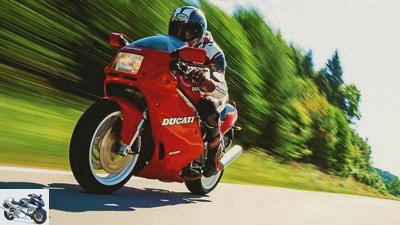
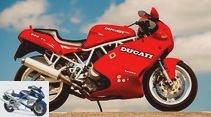
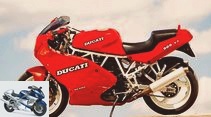
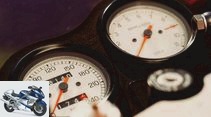
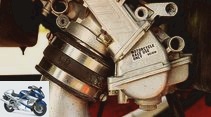
11 photos
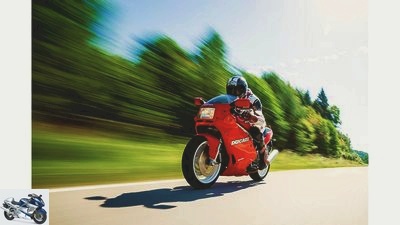
1/11
Unobstructed view through the airy tubular space frame.
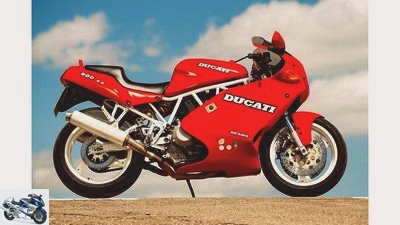
2/11
Ducati 900 SS.
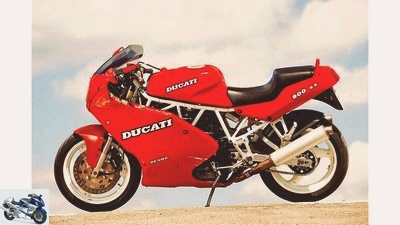
3/11
Ducati 900 SS.
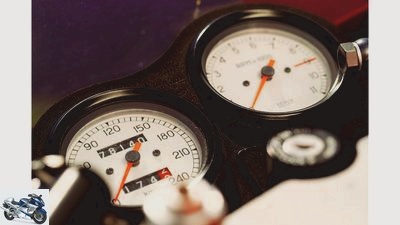
4/11
The view of the instruments highlighted in white is pleasing to the eye, despite the unusual 30-digit division.
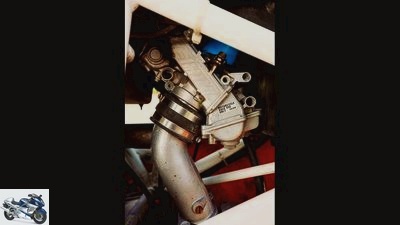
5/11
Flat slide carburetor, long intake paths, full torque.
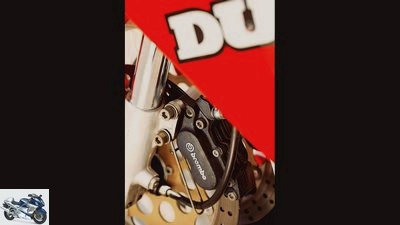
6/11
In the first year the calipers wore black.
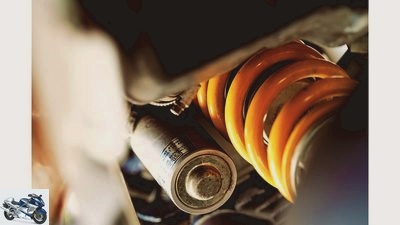
7/11
Hard but hearty. The shock absorber writes more stability than comfort.
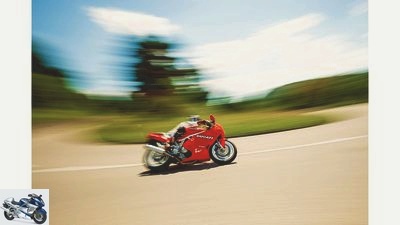
8/11
Slim, light, with a punchy center.
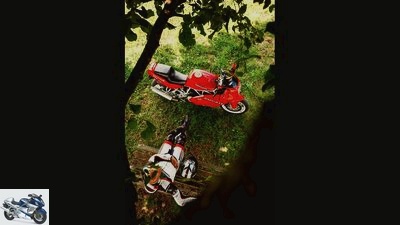
9/11
The Ducati not only delights on lonely, winding streets, but also when looking at it.
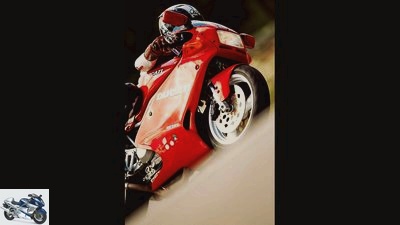
10/11
The 900 SS cost 18,980 marks back then (in 1991).
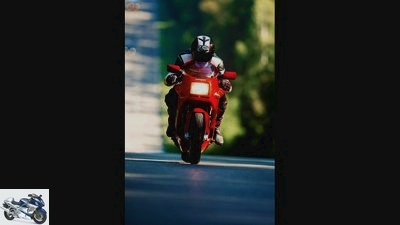
11/11
The Ducati can do more than just look good..
Impressions from the Ducati 900 SS
Italian for beginners
Anyone who wanted to put some of the sporty shine of Ducati Superbikes in the garage at the beginning of the 90s had to dig deep into their pockets. Until 1991 the Ducati 900 SS appeared. It made entry into the Desmo world affordable and hit like a bomb.
What then, she’s already 25 years old? Thunderstorm! ”The reactions are always the same when talking to neighbors or passers-by about the Ducati 900 SS comes into conversation. Amazement, enthusiasm for the simple, clear forms, the aesthetics. In fact, fiery red Bella still cuts a fine figure today, and it is not difficult to imagine that in 1991 she turned the heads of fans and became a success. Especially since she didn’t have to follow in too big a footsteps. Because its predecessor with its chubby shapes, tire dimensions that took getting used to and the mimosa-like Weber double carburetor had only little popularity.
Buy complete article
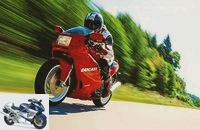
Impressions from the Ducati 900 SS
Italian for beginners
Ducati 900 SS can do a lot more than just look good. Because in order to convince the fans also in terms of driving dynamics, they got the best systems on the way.
Fully adjustable shock absorber and upside-down fork
First and foremost, there is the simple and stable tubular steel space frame. The directly hinged shock absorber is fully adjustable, as is the upside-down fork. Showa delivered both. The shock absorber is supported directly by a pretty aluminum swing arm, no wiring harness or a disdainful battery disturbs the clear view through the airy tubular frame. The battery was neatly placed under the folding tank of the Ducati 900 SS. And Brembo contributed two 320 mm discs in the front wheel with four-piston calipers. But despite all the super sports attitude, the seating position appears surprisingly relaxed, more like touring. No pinching backs of the knees, no deep bow to get to the somewhat idiosyncratic cranked stub. Only the tank is a bit long by today’s standards.
The starter has no trouble balancing the two pistons above their top dead center. The V2 starts work spontaneously and reports to the place with a gentle drumming. Bom-bom-bombom, he puffs and stomps with rich, soft, pulsating blows. Almost free of mechanical background noise. Despite its proud 78,000 kilometers. Yes, the air-cooled engines were more reliable than their reputation. What the author, himself a long-time owner of such a Ducati 900 SS, can confirm from his own experience. Careful handling assumed. First and foremost, that meant warming up carefully, changing the oil and timing belt regularly. The dry clutch contributes its characteristic rattle that tastes wonderfully like racing – albeit well muffled. Many provided their proper hearing through open carbon clutch covers.
The steering angle is really puny
Oh man, was the clutch really that difficult back then? You have to give it a go. Ducati has that better under control today. The tropic thing too. How was that in the driving school again? Turn in three moves? The steering angle is really puny. Small disadvantage of the tubular space frame, which got wide in the steering head area. But as soon as the Ducati 900 SS rolls, a good mood spreads. First of all, because the Supersport has become such a wonderfully slim, compact motorcycle. A Ducati 888, on the other hand, is a real dream.
In previous tests, the Ducati 900 SS did not exactly gain a reputation for being overly manageable. To get the red on course, you need a stronger impulse on the handlebars than low weight and slim lines would suggest. But that’s not unwieldy or even stubborn.
The world is all right again at the corner exit
In contrast, it is bomb-proof. The small Ducati 900 SS already has the feeling of “walking around the corner on rails” in its repertoire. Especially in long arcs, it persistently follows the chosen course, undeterred by bumps. It can be driven quickly and diagonally through the curves. A really fine curve predator. The fork is extremely easy to swallow. The shock absorber parries long waves with sufficient comfort. But it rules with severe severity on short, hard blows. Just old Italian school. Only at the exit of the curve does the Signorina always strive for the wide line, and is not too open to course corrections in an inclined position. But the world is fine again at the corner exit.
Because the air-cooled two-cylinder, whose crankcase is still based on the Pantah engines, is an excellent partner for country road racing. In the lower gears he takes on the gas from 2500 rpm without chopping. When the orange needle passes 3 on the white face of the Veglia tachometer, the two-valve engine tenses the muscles. Based on a beefy torque curve, things are going well. The twin of the Ducati 900 SS runs as smooth as butter. In fairness, however, it must be mentioned that the model we drove was retrofitted with Keihin flat slide carburetors. A tried and tested and often used measure to help the V2 to be more spontaneous and pressure in the middle. The necessary gas factories were supplied by Keihin and Mikuni (with TÜV).
Modern interpretation of the Supersport comes in 2017
And so every gas opening accompanies the characteristic chirping of the flat slide, while the twin pulls ahead powerfully and underlines its start with a bassy, but never obtrusively loud soundscape. 5000, 6000 revolutions are sufficient in most cases. And if you have just asked yourself how Supersport and just 73 hp go together, you rub your eyes in amazement. They fit. The 900 was never an ambitious lathe operator, however. It already reaches its top performance at civilian 7000 rpm. The red line on the pretty rev counter, however, only waits at 9000 rpm. Turning it out makes little sense, the two-cylinder looks rather tough and trying. Then rather early in the six-speed gearbox, which he took over from the Superbike 851, step into the next gear accurately and let the torque sweep you out of the bend with full swing. 73 hp are completely sufficient for this. Actually, the Ducati 900 SS fits perfectly into the present, in which the performance discussion is actually no longer, but emotions and beautiful design are all the more in demand.
But then please also with modern brakes. Because despite the impressive dimensions, an acceptable delay can only be pressed out of the two 320 discs with a lot of manual force. The weak point is quickly identified with the cheap 16 mm hand brake pump. Which is why many pilots quickly switched to a milled radial brake pump with a piston diameter of 19 mm. Nevertheless, such a country game with the Duc is an invigorating thing. It accelerates the pulse even without peak values, you get admiring looks and you get a little brooding. It goes without saying that the Ducati 900 SS had to be a success at the time. And could be again. Because Ducati has rediscovered the idea of a not too extreme, light sports car for the road, which puts drivability before top performance, and in 2017 it will send a modern interpretation of supersport into the race.
Technical data Ducati 900 SS
engine: Air / oil-cooled two-cylinder four-stroke 90 degree V-engine, desmodromic valve control, two valves per cylinder, carburetor, Ø 38 mm, hydraulically operated dry clutch, six-speed gearbox, O-ring chain, bore x stroke 92 x 68 mm , 904 cm³, 54 KW / 73 PS at 7000 / min, 82 Nm at 5000 / min
landing gear: Tubular steel frame, upside-down fork, Ø 41 mm, two-arm swing arm made of aluminum, central spring strut directly hinged, double disc brake at the front, Ø 320 mm, four-piston fixed calipers, disc brake at the rear, Ø 245 mm, two-piston fixed caliper, rims 3.50 x 17; 5.50 x 17, tires 120/70 ZR 17; 180/55 ZR 17
mass and weight: Weight with a full tank 198 kg
price (1991): 18,980 marks
Related articles
-
Ducati SuperSport in the driving report
Ducati 24 pictures Ducati 1/24 The entry into the sporty Ducati world takes over the SuperSport again with immediate effect. For the first trial ride, Petrus …
-
BMW R 90 S, BSA Rocket 3, Ducati 750 SS, Kawasaki 900 Z1
Jahn 12th photos markus-jahn.com 1/12 BMW R 90 S, BSA Rocket 3, Ducati 750 SS and Kawasaki 900 Z1 are ready to go. markus-jahn.com 2/12 … Occasionally…
-
Top test Ducati Hypermotard 1100 S
Artist Top test Ducati Hypermotard 1100 S Bella Figura Whether randale grande or dolce vita. Everyone cuts a fine figure with the Ducati Hypermotard. But…
-
Race track comparison Aprilia RSV Mille RR against March Ducati 996 R
Gargolov Race track comparison Aprilia RSV Mille RR against March Ducati 996 R Border crossings No or only the smallest compromises, only pursuing the…
-
Track test superbike Ducati 999 R
wolf Track test superbike Ducati 999 R Celebrate the 100 The start number 100 is stuck to the fairing, MOTORRAD is celebrating its 100th anniversary:…
-
Driving report Ducati Hypermotard
Jahn driving report Ducati Hypermotard (2007) Hyper, Hyper There have only been a few innovations in recent times that have caused so much attention and …
-
Ducati SuperSport in the top test
Arturo Rivas 17 pictures Rivas 1/17 Engine: The good side of the Supersport is its extremely powerful two-cylinder. He’s got the punch on the right …
-
Comparison test Ducati Monster 797 and Suzuki SV 650
Artist 28 pictures 1/28 Ducati Monster 797 and Suzuki SV 650 in the comparison test. 2/28 Ducati Monster 797: Modern, the first: The …
-
Artist Ducati 998 S Final Edition The Diva is leaving The 998 S Final Edition is without a doubt a motorcycle of today. But no matter where and how you move them ?? …
-
Driving report Performance Ducati 999 S
Driving report Performance Ducati 999 S Pressure-tight Ducatisti are extremely fond of renovations. So what could be more obvious than providing the…